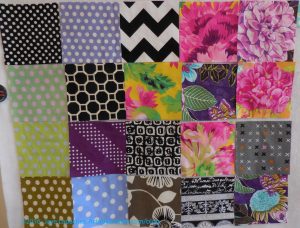
Yes, I have finally started cutting for FOTY 2016. It took me forever, I know. Next year will be different.
Commentary about works in progress, design & creativity
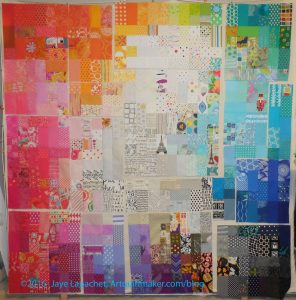
I made some progress on getting FOTY 2015 sewn together.
I have big chunks, so ~6 seams and I am done.
Sort of.
I have some problem areas that need partial seams or something. I haven’t quite figured it out yet. Partial seams is the best I can do now, but how is the challenge.
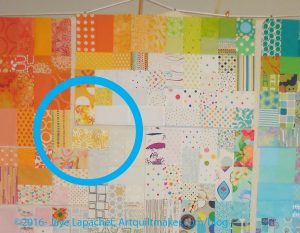
Problem area #1
I think you will have to enlarge the photo (there still may be a problem with enlarging the photos. Sorry, if that is the case; I am working on it) to see that yellow that lines up nicely with the top chunk.
It doesn’t line up with the bottom chunk.
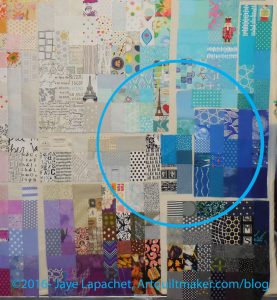
Blue Area Problem child #2
This area is a little more difficult. There are more pieces that are problematic and there are more of them.
None of this is mission critical. I will get through it and it won’t be a huge drama. It feels dramatic at this moment. Tomorrow is a new day and things will look different.
2016 To Do List
I haven’t felt motivated enough to get busy on one of these projects, but I feel the urge.
A la Pam, and thanks to Pam, I have been keeping track of my fabric usage. My goal is not to get rid of my stash, though I do want to use my stash, which means I am not telling you my Net totals. To date I have used almost 60 yards of fabric, 22% of which is for charity. I am really thrilled to have used that much and I can’t wait to see what my totals are for next month. I don’t know how many finishes I will have by then, but it is exciting to see progress.
*New since last post
Finished since December 2015 post
I finally made it to a Sew Day at the new BAMQG location.
Gerre emailed me while I was in Portland and asked if I was going. I thought ‘why not?’ and Gerre was willing to sew with me again. Even though the YM is home and lounging around, he is old enough to be alone and didn’t want to come with. Why would he? He would be bored.
It was fantastic! I was thrilled to be there and thrilled to be sewing. Gerre brought the Orange T quilt and it is finished. I have to take some photos and then I will post a finished photo.
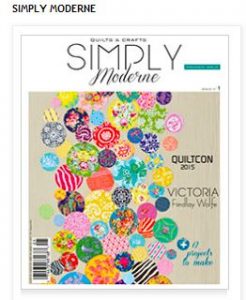
We had a great time sewing and chatting and working on our quilt. We had decided to work on a circle quilt as a donation quilt. We got the inspiration from Simply Moderne magazine. I was attracted by the cover and bought an older issue at QuiltCon.
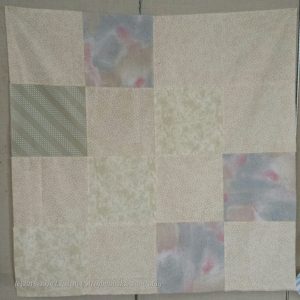
We started out by cutting the background pieces in the Pushed Neutral technique I learned from Mary Mashuta 1,000 years ago.
I brought the neutrals and Gerre brought the foreground fabrics, though we didn’t know it would end up that way.
We had talked about using greens, so I brought my green bins along with my beige and brown bin (which thankfully is almost empty). We pulled out the last of my light and tolerable beiges and cut them into 10″ squares and put this together as a background.
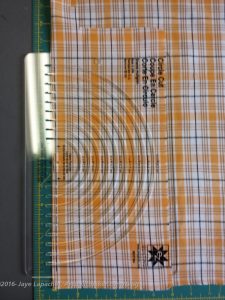
Gerre then showed me some plaids she had and we decided to use the plaids instead of greens and make a boy quilt. We cut circles using both the Go cutter than Pati brought (with her circle template!) and my newish circle cutting ruler.
I wielded the circle ruler while Gerre took over the Accuquilt Go! I only had my normal 45mm rotary cutter and I think it would have worked better with a smaller cutter. I only have one of those and it was at home, so I did the best I could. I may need a new blade after cutting the circles.
We decided not to have a lot of large circles, because the size of our quilt was smaller than the example we saw in the magazine and we didn’t want the entire surface to be covered.
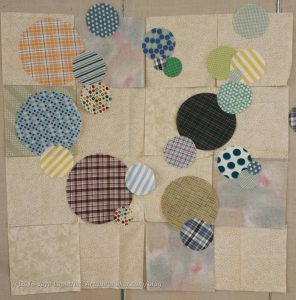
After putting the background together we laid out the circles on the background. I didn’t take a picture of that stage so you have to be satisfied with the photo on the right.
We decided we had to do the quilt in layers so that we could sew around a whole circle and not have to stop and start.
We didn’t bring fusible so we glued the first layer of circles down on the background, pressed it and then Gerre sewed.
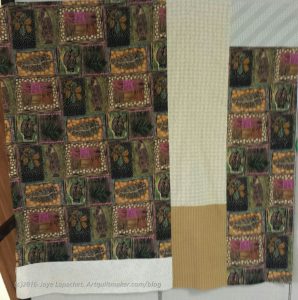
While she sewed, I worked on the pieced background.
The fish and leaf fabric is OLD! The selvedge says “Sykel Enterprises 1993.” I don’t even know if Sykel exists anymore. It is certainly no Moda or Kaufman. I am sure TFQ could tell me where I bought it. 😉
It was in the brown bin and good for a boy quilt. I also had about a yard, which was a great start. It was in two pieces, so I added the strip in the middle. We also cut off a strip so we could see about applique’ing some of the motifs somewhere on the quilt. The center plaids are a couple Gerre brought.
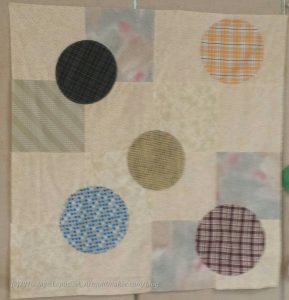
We were able to sew the first layer down. These were the largest circles.
We don’t intend to necessarily go from largest to smallest, but we wanted to start with the largest.
So far, it doesn’t look like much, but the next layer (no photo) looks better.
Stay tuned.
Yes, there are photo errors. For some reason since WordPress was updated it is not recording the location of my photos properly. This means that you can’t view the larger size of the photos. I know it is a pain.
I am working on figuring out the problem and will fix it as soon as possible. Thanks for all of your reports.
When you notice errors, please email me at poste [@] artquiltmaker.com. Thanks!
Along with Flowerburst, I also got back this quilt, which I wish I had called Cityscape. It really does look like a cityscape.
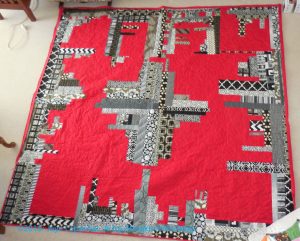
I have sewn on the binding. I worked at sewing one whole side per evening so the binding process only took me about 8 hours. The quilt is 82″ x 84″ so quite a bit of work. I used a Kona solid for the back and the binding and it was a pain. The needle doesn’t slide through that fabric like I think it should. I MUST remember that.
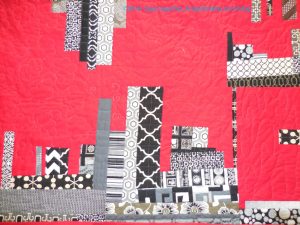
The red is the background and I had Colleen think of it as a sky and put clouds in it. She did four different types of clouds in the four quadrants. I think of it as the four seasons.
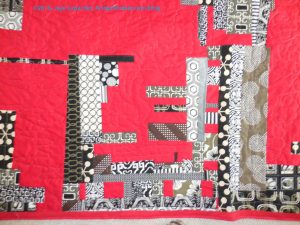
The black and grey are more like buildings, so she did more geometric quilting in those areas.
Now I need to put a sleeve on it.
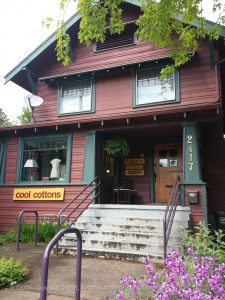
Last week I sped up to Portland to pick up the YM from college. Yes, he has completed his freshman year of college. I can’t believe it! Time has flown. Stay tuned about whether he finished successfully. I am sure he did, but…. well, you know.
I drove up in two days, which is hard. It is about 700 miles and that is two full days of driving. Of course, I stopped at a couple of quilt shops along the route – Ocean Waves Quilt Shop in Eureka (always a favorite and reviewed previously) and Forget-Me-Knots in Bandon. I was in Bandon in August on my way back from dropping the YM off and reviewed the shop at that time. Both are great shops and I didn’t see anything that would turn me off from visiting again.
The Young Man had some errands on campus on Friday regarding his fall schedule and I needed to not turn right around and drive 350 miles, so we did his errands and then went our separate ways for a few hours. He needed a nap and I needed to see some quilt shops. I had to drive but it wasn’t flat out highway driving.
First stop: Cool Cottons. I had heard about this shop and tried to find it last time, but we missed the exit. I checked the directions again and found that the hotel we stayed in last time was farther south than the interchange we needed, which was the problem. As a result, mom and I got lost on our way there and gave up. I was determined this time and found my way.
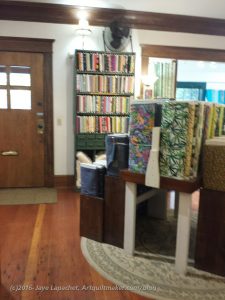
I was a little scared by the owner when I arrived, but she turned out to be very nice and very chatty. We talked a little about the transformation of the house where the shop was located. Of course, we also talked about projects.
The store is the bottom floor of a Craftsman style house. The transformation was very well done. It was also sensitively done, which is nice for such an architecturally interesting house.
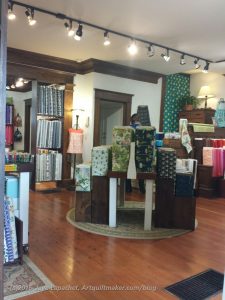
I loved their fabric and wanted almost EVERYTHING. I restrained myself and tried to buy things that I needed. I found some of the background fabric (see below) for the quilt I started in the Victoria Findlay Wolfe class. I wasn’t even looking for it, but when I saw it – well, what I think it the right color since I didn’t have a swatch, I bought enough for a background. If this isn’t the right color, I have enough for a background on another quilt. Buying this fabric means I have to actually work on that quilt! 😉
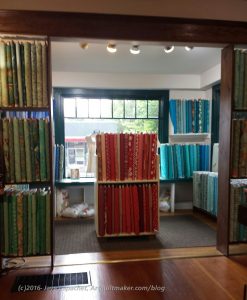
This shop has mostly modern fabrics, though not so many of them are the big prints. I saw lots of tone-on-tones / blender type fabrics as well as the various fabrics with motifs that come in lots of different colors like the Lizzy House Pearl Bracelets, the Timeless Treasures cross hatch fabrics, etc.
The shop had a lot of GREAT greys. I resisted, though I didn’t want to.
The selection of blues and turquoises was fantastic. They had a lot of in between colors, such as aqua, blue green, dark blue (like that StudioE blue I like so much) as well. Again, I was tempted to get one of each. Again, I restrained myself.
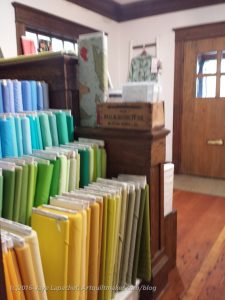
The stairs are used as display space for some of the solids, which was a great idea. In general, I thought the space was used very well for fabric. It was functional, appealing and very light.
The shop carried American Made Brands of solids. Yay! I didn’t see any Konas, but there could have been some.
I also saw an almost-full, if not full line of Peppered Cottons by Pepper Cory. Frances has talked about her and her fabric on the Off Kilter Quilt podcast. I hadn’t seen them in person before, so that was nice.
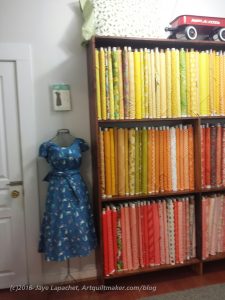
I would have bought more if they had had the fabrics I wanted in fat quarters. I know I go back and forth on fat quarters, but I am in restraint mode, so I am going with FQs some of the time lately. I am not complaining at all about the fat quarters at all. There were plenty of FQs in the shop, just not the ones I was considering. Also, I didn’t ask if they cut FQs, which I should have done to make this a complete review.
I was also pleased to see a really nice selection of sale fabrics. The two at the bottom of the photo below were both on sale. I will use the blue for the next food quilt and the pink was just interesting. There were also sale FQs.
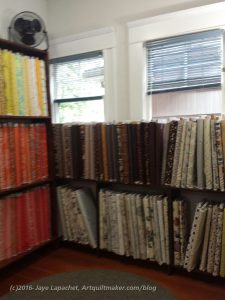
Prices were $11-12 per yard, which I have found to be normal in urban areas.
The neighborhood is interesting. There weren’t a lot of traffic lights, so I got some steps in by walking a few blocks to a signal with a cross walk. There is a nice looking bakery for non-GF people, a couple of interesting vintage shops and some boutiques. I had coffee at a place called Coava after my fiber expedition.
This shop was stuffed with fabric, but didn’t come across as messy. There were shelves of fabric, nicely arranged, in almost every available space. This is a shop I will definitely visit again.
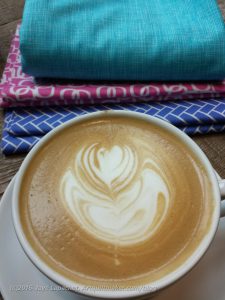
Above is my art shot of coffee and fabric. 😉
Cool Cottons
2417 SE Hawthorne Blvd
Portland, OR 97214
coolcottons@hotmail.com
503.232.0417
Monday: 10 – 6
Tuesday: 10 – 6
Wednesday: 10 – 6
Thursday: 12 – 8
Friday: 10 – 6
Saturday: 10 – 6
Sunday: 12 – 5
Ireland’s highest Waterfall, located in a beautiful Wicklow Valley at Powerscourt Estate.
Waterfall (Japanese: — Waterfall Climb) is a damage-dealing Water-type move introduced in Generation I. It is HM07 in Generations II, III, and IV; it is HM05 as of Generation V. Prior to Generation II, it was the signature move of Goldeen and Seaking. (Bulbapedia)
Waterfall enables brands, agencies and technology providers to directly engage subscribers across SMS, Passbook, QR Codes, mobile wallets, mobile coupons, MMS, IVR, etc
waterfall model – The waterfall model is a sequential design process, used in software development processes, in which progress is seen as flowing steadily downwards through the phases of conception, initiation, analysis, design, construction, testing, production/implementation and maintenance.
Definition: “A waterfall is a place where water flows over a vertical drop in the course of a stream or river. Waterfalls also occur where meltwater drops over the edge of a tabular iceberg or ice shelf.
Waterfalls are commonly formed in the upper course of the river.[1] At these times the channel is often narrow and deep. When the river courses over resistant bedrock, erosion happens slowly, while downstream the erosion occurs more rapidly.[1][2] As the watercourse increases its velocity at the edge of the waterfall, it plucks material from the riverbed. Whirlpools created in the turbulence as well as sand and stones carried by the watercourse increase the erosion capacity.[1] This causes the waterfall to carve deeper into the bed and to recede upstream. Often over time, the waterfall will recede back to form a canyon or gorge downstream as it recedes upstream, and it will carve deeper into the ridge above it.[3] The rate of retreat for a waterfall can be as high as one and half meters per year.[1]
Often, the rock stratum just below the more resistant shelf will be of a softer type, meaning that undercutting due to splashback will occur here to form a shallow cave-like formation known as a rock shelter under and behind the waterfall. Eventually, the outcropping, more resistant cap rock will collapse under pressure to add blocks of rock to the base of the waterfall. These blocks of rock are then broken down into smaller boulders by attrition as they collide with each other, and they also erode the base of the waterfall by abrasion, creating a deep plunge pool or gorge.
Streams become wider and shallower just above waterfalls due to flowing over the rock shelf, and there is usually a deep area just below the waterfall because of the kinetic energy of the water hitting the bottom. Waterfalls normally form in a rocky area due to erosion. After a long period of being fully formed, the water falling off the ledge will retreat, causing a horizontal pit parallel to the waterfall wall. Eventually, as the pit grows deeper, the waterfall collapses to be replaced by a steeply sloping stretch of river bed.[1] In addition to gradual processes such as erosion, earth movement caused by earthquakes or landslides or volcanoes can cause a differential in land heights which interfere with the natural course of a water flow, and result in waterfalls.
A river sometimes flows over a large step in the rocks that may have been formed by a fault line. Waterfalls can occur along the edge of a glacial trough, where a stream or river flowing into a glacier continues to flow into a valley after the glacier has receded or melted. The large waterfalls in Yosemite Valley are examples of this phenomenon, which is referred to as a hanging valley. Another reason hanging valleys may form is where two rivers join and one is flowing faster than the other.[1] Waterfalls can be grouped into ten broad classes based on the average volume of water present on the fall (which depends on both the waterfall’s average flow and its height) using a logarithmic scale. Class 10 waterfalls include Niagara Falls, Paulo Afonso Falls and Khone Falls.
Classes of other well-known waterfalls include Victoria Falls and Kaieteur Falls (Class 9); Rhine Falls and Gullfoss (Class 8); Angel Falls and Dettifoss (Class 7); Yosemite Falls, Lower Yellowstone Falls and Umphang Thee Lor Sue Waterfall (Class 6); Sutherland Falls (Class 5).[4]” (Wikipedia)
A free screensaver is definitely cheaper than a round-trip ticket to an exotic locale. This Waterfall Screensaver displays a realistic picture of a waterfall.
indoor waterfalls
waterfall kits
Post the direct URL (link) where your drawing, doodle, artwork is posted (e.g. your blog, Flickr) in the comments area of this post. I would really like to keep all the artwork together and provide a way for others to see your work and get familiar with your blog or website.
The Creative Prompt Project, also, has a Flickr group, which you can join to post your responses. I created this spot so those of you without blogs and websites would have a place to post your responses.
We are also talking about this on Twitter and Instagram. Use the hashtag #CPP
Waterfall or waterfalls may also refer to:
As mentioned in yesterday’s FOTY post, I need leaders and enders. Donation patches inevitably end up doing the job. I made a bunch and have an idea for a red and white donation quilt. I don’t have all the details in my head yet, but I am working on blocks using red fabrics to go with the plain whites.
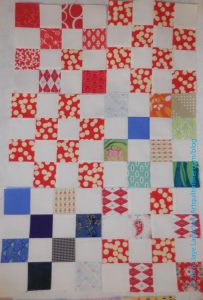
I don’t have an unlimited selection of red 2.5″ squares cut, so I am also making donation blocks using other colors. I will donate those blocks to the Charity Girls and they can do something with them unless I have enough blue and green blocks and enough time to make a second donation top. We will see.
It was fun to make the donation blocks. I am playing with the arrangement of colors and different fabrics. The recipients may not know but I have fun and I hope the quilt absorbs my joy.
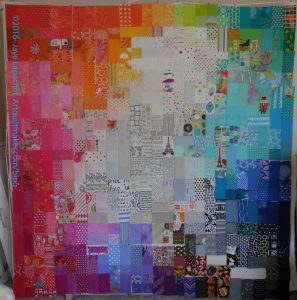
I blew through the layout stage and am on to piecing.
Well, relatively anyway.
I gave myself a certain amount of time to do the layout. The time period was about two weeks and during that time, I didn’t take my cutting table or other in-process projects out of the fabric closet. I only allowed myself to work on other projects as leaders and enders and focused on getting this laid out.
This year’s piece was harder to arrange, because the fabrics I used were really different colors than each other. I am not sure why, because individually they don’t look different. The differences in each hue don’t really show up until you put two oranges or pinks next to each other and try and decide which has a lighter and which has a darker value. It is very strange. If I had thought of it I would have kept track of manufacturers and designers to see if I bought different ones this year than last year. I didn’t know that this would happen. It would have also meant that I would have had to keep track last year as well. More data would be needed.
The too-small design wall was a real problem this year, I think. I did not cut the patches down to accommodate the design wall as I did last year. I just crammed them all on the wall. That means that I found some places where I was short. You can see some white spaces on the bottom (near right hand corner). This problem showed up when some of the fabric was taken up by seam allowances and I was able to line patches up more evenly. I have to rummage through my leftover pieces and find some to fill in.
Most of the piece has been sewn into chunks. The chunks are not even because I had some rectangles arranged horizontally and some arranged vertically. With the squares it made for interesting piecing.
The difficulty was what it was and I got the feeling that it was done at some point and started sewing. I talked a little about the sewing when I posted about the Peacock. It is all about leaders and enders, because I only want two unsewn patches off the wall at a time to ensure the piece stays laid out the way I intended.
You can find out more about the FOTY quilts on the series page.
In my last post on this topic, I was feeling as though I was on the verge of finishing several projects. I have two large quilt projects well in hand, but nothing else, really. I guess that means I am still on the verge or was mistaken or could have been experiencing a bout of wishful thinking.
Finished 2016 Quilt Projects
Cityscape/Red & Black Improv Quilt – I still have to put the sleeve on, but the binding is on, so it is ready to go.
Flower Sugar donation quilt (I feel odd putting this finish here as there is so much I didn’t do on this piece – still there isn’t anywhere else to put it)
Finished 2016 non-Quilt Projects
In Process
The ‘In Process’ is used to denote projects on which I am actively working or pretending to stitch.
Still WIPs
I still have WIPs. Who doesn’t, after all? A project in the ‘UFO’ category means I am stalled. A nicer way of saying UFO, to me, is a WIP. The list is a lot shorter and the projects are newer, for the most part.

Ready for Quilting
Wow! Everything on this list is new, as in it was never on the original 26 Projects list.
In Quilting Process
Nothing being quilted.
Binding
Hunting and Gathering
What’s on your list?
Flowerburst returned from the quilter about a week and a half ago. I have had so many other projects going on that I haven’t had time to post about it. I haven’t really worked on it either, so there hasn’t been much to say.
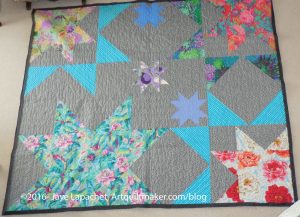
As you might remember, Flowerburst is a large quilt made from a pattern in Kathy Doughty’s book, Adding Layers. I wrote a review about that book. Have you read it?
The photo is a little odd as I had to lay the quilt out on my living room floor and take the photo from the upstairs hallway (I have an open plan, mid-century modern house). When I get my other quilt hanger back from college and the quilt is bound, I’ll take another photo.
This was supposed to be a quick project and it was relatively. I didn’t like the directions, mostly because I had to conserve fabric, so I used different methods to cut the backgrounds, which meant I didn’t have as many leftovers as I would have if I had used KD’s methods. I understand the reasoning behind her cutting directions: she had to write directions for everyone not just for me, the person with the fabric shortage.
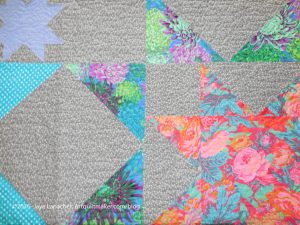
I like the way this quilt turned out. I liked using my big prints on the front for a change even though I will be gifting this quilt and won’t get to see those lovely prints very often.
I really like the idea of combining different sized blocks and think this, or a variation of this, pattern has potential for other layouts. I am thinking that a slightly larger block in the center with the smaller block would have worked as well. I think there could have been some transparency work as well, if I were willing to do a larger quilt.
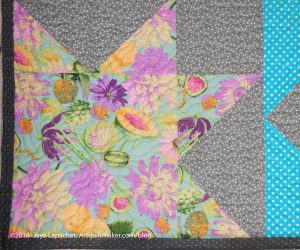
A couple of the prints are Martha Negley prints, but they go so well with the Philip Jacobs prints.
The print on sea green with the flowers and melons is a favorite and was close to being a dress. I decided at the last minute that I couldn’t risk a melon ending up on a breast or buttock! I do love those flouncy lavender flowers, though. I also love the cantaloupe color combined with the sea green. I don’t remember seeing that combination before and will have to remember it in future.
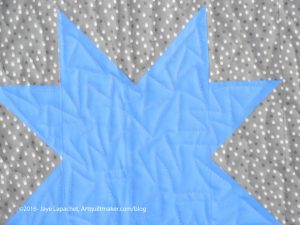
Finally, Colleen did a great job on the quilting. I wanted her to highlight the stars and she did different designs in each one and they look great. I can’t wait to bind this and see what my niece thinks.
As I said the other day in the latest donation blocks post, laying out FOTY 2015 doesn’t make for a lot of tangible production. While I enjoyed making the donation blocks, I did need a little variety and the Stepping Stones parts were handy.
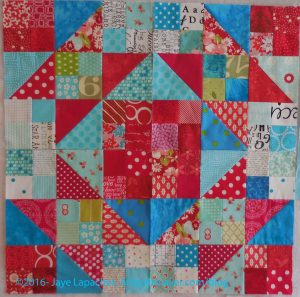
I enjoy these blocks and seeing the way they will be laid out makes me very happy. Turning each on a little bit makes a huge difference.
Even though I may need the squares for the layout of the Carpenter’s Wheel blocks, I have used some of the low volume prints for the white space in these blocks. I have plenty of fabric for the [mythical] Carpenter’s Wheel layout and can always cut more.
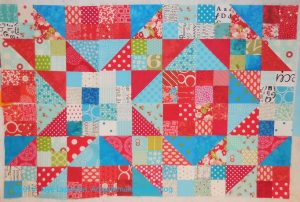
Making a few blocks always leads to making more and the six shown give an idea of what the quilt will look like and makes me want to make more.
Based on the layout I devised for my nephew’s Stepping Stones quilt, it looks like I will only need two more blocks and then border blocks for the width. I thought I measured 8 blocks across my bed, which doesn’t account for border blocks. I want to make the border blocks to finish the design. There are two blocks around the whole edge of the previous SS quilt and I could eliminate those if I thought the width was too big. Measuring next, I think.
I am really pleased with how the blocks look. Now to get FOTY 2015 off the wall so I can layout all the blocks I have and see what I am facing. After months of feeling meh about quiltmaking, I am finally excited about several projects! Yay!
I know I just posted a few days ago and for you looking at a computer screen the changes to the piece are hard to see. I promise not to give you a patch by patch update.
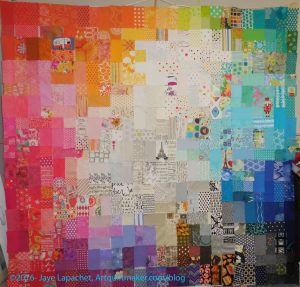
Now is the time where the changes are very subtle and looking for changes in the shape of the areas of color are the best way to See the evolution. I worked quite a bit more on the red and pink areas. “Working on an area” means getting the darkest or lightest fabrics together and blending the mediums into a smooth transition between the two. Mostly it means deciding where a piece goes. As I have said that is not always easy and in this case, I am struggling with some of the off colors in each area with no way to smooth the transitions. Green is a particular problem for me this time around. Green, never a favorite, has a bunch of grey greens included this time and they don’t seem to fit in either grey or green.
That is the way of it, though, and at some point, I have to stop and say enough is a enough.
military uniform
Uniform is a creative consultancy that works with organisations [sic] that want to re-imagine their business and go beyond the possible. Studios in Liverpool & London.
Innovative dairy farm management software for professional dairy farmers.
uniform distribution – In probability theory and statistics, the discrete uniform distribution is a symmetric probability distribution whereby a finite number of values are equally likely to be observed; every one of n values has equal probability 1/n.
Definition: “A uniform is a type of clothing worn by members of an organization while participating in that organization‘s activity. Modern uniforms are most often worn by armed forces and paramilitary organizations such as police, emergency services, security guards, in some workplaces and schools and by inmates in prisons. In some countries, some other officials also wear uniforms in their duties; such is the case of the Commissioned Corps of the United States Public Health Service or the French prefects. For some public groups, such as police, it is illegal for non members to wear the uniform. Other uniforms are trade dresses (such as the brown uniforms of UPS).” (Wikipedia)
continuous uniform – In probability theory and statistics, the continuous uniform distribution or rectangular distribution is a family of symmetric probability distributions such that for each member of the family, all intervals of the same length on the distribution’s support are equally probable. The support is defined by the two parameters, a and b, which are its minimum and maximum values. The distribution is often abbreviated U. It is the maximum entropy probability distribution for a random variate X under no constraint other than that it is contained in the distribution’s support.
2003 film
uniform convergence – In the mathematical field of analysis, uniform convergence is a type of convergence stronger than pointwise convergence. A sequence {fn} of functions converges uniformly to a limiting function f if the speed of convergence of fn to f does not depend on x.
school uniforms
A uniform is a standard set of clothing identifying the wearer as a member of an organisation.
Uniform may also refer to:
Post the direct URL (link) where your drawing, doodle, artwork is posted (e.g. your blog, Flickr) in the comments area of this post. I would really like to keep all the artwork together and provide a way for others to see your work and get familiar with your blog or website.
The Creative Prompt Project, also, has a Flickr group, which you can join to post your responses. I created this spot so those of you without blogs and websites would have a place to post your responses.
We are also talking about this on Twitter and Instagram. Use the hashtag #CPP